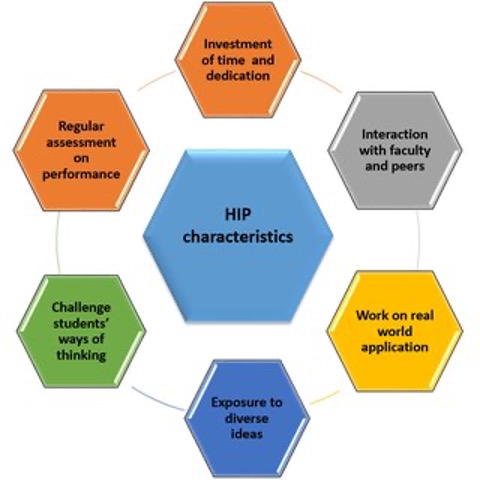By Megan Haskins, Faculty Developer of Integrative Learning and High-Impact Practices, and Paula von Kretschmann, Instructional Designer.
Overview of collaborative assignments
Instructors in STEM fields are uniquely positioned to integrate High-Impact Practices (HIPs) into their courses because these programs are often focused on the ability to apply new knowledge and skills to real-world problems. Many courses include group projects that require students to explore, create, and build using what they have learned. In addition to this application, the most successful courses also require students to articulate the how and why behind their experience. These assignments provide a foundation for high-impact learning, which promote student retention, engagement, real world relevancy and scholarship (Kuh, 2008). This post will focus on Collaborative Assignments as a High-Impact Practice, though many other practices apply to STEM fields.

Collaborative work can take shape in many forms and modalities, whether in-person, online, or both. Students gain valuable career skills when they are provided opportunities to utilize relevant technologies in collaborative spaces. George Kuh’s (2008) High-Impact Educational Practices: What They Are, Who Has Access to Them, and Why They Matter defines Collaborative learning as “combin[ing] two key goals: learning to work and solve problems in the company of others, and sharpening one’s own understanding by listening seriously to the insights of others, especially those with different backgrounds and life experiences.”
Collaborative assignments provide students with opportunities to hone the collaborative skills needed to successfully transition to professional environments. In order to maximize these opportunities, instructors should design assignments that align with the components of high-impact learning.
What makes a HIP high-impact?
It’s important to note that high-impact practices are not impactful by default, but instead must incorporate conditions of effective educational experiences. These conditions include significant effort over an extended period of time, sustained collaboration with faculty and peers, interactions with diversity, frequent feedback, variety of learning settings, and deeper learning and self-awareness (NESSE, 2007; Kuh, 2008). This blog will unpack some of these high-impact elements, provide suggestions for application, and conclude with additional resources.
- Multiple opportunities to collaborate with peers– Students should have multiple, varied opportunities to communicate in a collaborative environment (Garrison, 2020; Jeong & Hmelo-Silver, 2016). These conversations establish a common set of goals, clear expectations for individuals, and provide space for questions and challenges to be resolved (,2018). Additionally, these spaces expose students to diversity of thought, background, lived experience, and more. Below are some examples of how peer collaboration can be optimized in collaborative assignments:
- Asynchronous Discussion– Students should have space to discuss their work in collaborative environments that provide space for students to consider, draft, and revise their communication. Canvas discussion boards can facilitate this communication. Specifically, discussion boards that are assigned to working groups provide space for student groups to discuss their process in a low-stakes format that still allows instructors to engage in the conversation. Additionally, offering students a private space for conversation facilitates autonomy and ownership of group work.
- Small Group Check-Ins– Groups benefit from pre-determined, scheduled check-ins to mark progress and determine future steps. While students may take ownership of these meetings, instructors should provide suggestions on details such as frequency of meetings, talking points, and deliverables. When possible, a template for a meeting agenda is a useful model for students. Additionally, these agendas can be used in feedback conversations with the instructor.
- Group Contracts– Instructors may incorporate group contracts, or agreements, that outline workload and expectations. Throughout the course of the project, these agreements provide clear expectations for individuals, markers of progress for the group, and insight for the instructor. At the conclusion of the assignment, the group contract serves as an artifact for individuals to accurately represent their role to an external audience. For more information on group projects, check out this resource by the University of Waterloo’s Centre for Teaching Excellence.
- Collaborative Writing– Written communication is consistently cited as one of the most marketable and sought-after skills, regardless of the career field. Additionally, the opportunity to develop collaborative written work challenges students to refine their communication, time management, and problem-solving skills. When possible, instructors can assign a brief write up that requires the group to reflect on their product and experiences. When reflective assignments are incorporated, instructors should include clear expectations, a description of how the piece will be assessed, and, when possible, an example. It is important to remember that students are being asked to complete a vast array of written assignments across the disciplines, so instructor’s expectations should be clear and time should be allotted for questions. Reflective assignments can also be incorporated with different modalities, such as a video or audio submission, to accommodate different ways of learning, Universal Design for Learning (UDL), and neurodiversity.
- Multiple opportunities to engage with professor– Instructors should predetermine points of contact for collaborative work. This includes communicating initial expectations, problem solving discussions, and multiple forms of feedback.
- Articulate expectations– Assignment expectations should be clearly outlined to students in advance of the deadline and in multiple formats. First, the syllabus should outline major assignments and expectations for collaboration. Assignments should include a prompt for students to revisit as well as a rubric with behavioral anchors. If time permits, instructors can review syllabus or assignment prompts in an active learning space by providing opportunities for students to annotate and discuss their understanding of the written expectations.
- Multiple modes of communication– Instructors should clearly articulate feedback through multiple modes of communication. A few suggestions include: a poll at the start of Zoom class, Canvas prompts that are ungraded and foster back and forth communication with the instructor, accessible office hours (whether drop in or by appointment), and clear email guidelines.
- Informal feedback– Collaborative assignments should receive multiple iterations of informal feedback. This might look like a brief breakout room with each group to check in and troubleshoot their work, a brief survey for students to articulate strengths and challenges, or an annotated assignment draft.
- Formal feedback– Ideally, students will receive formal feedback prior to a final grade being assigned. This formal feedback may look like a draft grade with an opportunity to revise or a summative rubric that is annotated with opportunities to improve.
- Varied and iterative reflective prompts– Students prescribe value to classroom experiences when they see direct real-world application. Well-designed reflective prompts challenge students to think as individuals, recognize the significance of their learning, draw connections between their experiences, and communicate their self-assessment to an external audience (Yancey, 2009).
- Preparation prompts– When assigning a collaborative assignment, provide space for students to articulate how they work in a group setting, define collaboration, and articulate points of uncertainty about working with others. These reflections may be shared (anonymously) or discussed in groups. This reflection prepares students to consider how they position themselves in group work.
- Process prompts– Provide opportunities for students to write (or speak) about their collaborative process. When possible, draw connections to their career field and cocurricular experiences.
- Post-assignment prompts– Provide space for students to reflect on their experiences. This reflection can be an opportunity for collaborative expression that may be formal (a conclusion or appendix to the project) or informal (a word cloud that is shared in class).
- Artifacts to display to external audiences– In order to display learning to an external audience, students need evidence of their experience to demonstrate critical thinking and connections from their learning (Light, Chen, & Ittelson, 2012). Whenever possible, instructors can facilitate this by providing time and space for students to gather and archive images, reports, graphics, or other tangible artifacts.
- Develop artifacts– Provide suggestions for how students might capture evidence of their experience with the assignment. This might include images, renderings, stock photos, charts, graphs, written reports, etc.
- Digital ethics– Provide resources about representation of self and others, copyright and fair use, and other issues that may arise with artifact inclusion. Note, this is particularly important to instructors of students that may be working with corporations, grants, government contracts, etc. that may have contractual and/or legal obligations, such as non-disclosure agreements.
Next Steps and Resources
The OTL is here to support you in implementing or revising collaborative assignments or other HIPs in your courses. Below are a few resources to get started.
- Schedule a one-on-one consultation with an Instructional Designer to discuss your ideas. Download our ID Information document to see what other topics our ID’s can support.
- Check out the various opportunities for collaboration and support on the OTL calendar.
- Looking to introduce HIP’s while encouraging inclusivity? Check out our Inclusive Teaching Checklist from the Inclusive Teaching Practices department.
- Transitioning from online to Hyflex/Hybrid? Our Teaching Toolkit web page includes worksheets for a variety of modalities.
References
Garrison, R. (2020). Community of Inquiry (CoI) Framework and Online Teaching. Reflective Teaching in a Digital Age [Audio podcast], 1(3). Buzzsprout. www.reflectiveteaching.buzzsprout.com/1384834/5950516-dr-randy-garrison-community-of-inquiry-coi-framework-and-online-teaching
Jeong, H. & Hmelo-Silver, C.E. (2016). Seven affordances of computer-supported collaborative learning: How to support collaborative learning? How can technologies help?” Educational Psychologist 51(2), 247-65.
Kuh, G. D. (2008). High-impact educational practices: What they are, who has access to them, and why they matter. Association of American Colleges and Universities.
Light, T., Chen, H., & Ittelson, J. (2012). Documenting learning with ePortfolios a guide for college instructors. Jossey-Bass. https://du-primo.hosted.exlibrisgroup.com/permalink/f/1vj5nol/01UODE_ALMA511114514470002766
Johnson, K., Powell, A., & Baker, S. (2018) Learning Communities. In K. E. Linder & C. M. Hayes (Eds.), High Impact Practices in Online Education, Research and Best Practices. Sterling, VA: Stylus.
National Survey of Student Engagement (NSSE). (2007). Experiences That Matter: Enhancing Student Learning and Success. Bloomington, IN: Indiana University Center for Postsecondary Research. https://files.eric.ed.gov/fulltext/ED512620.pdf
Pusca, D. & Northwood, D. (2018). Implementation of high-impact practices in engineering design courses. World Transactions on Engineering and Technology Education. 16. 108-114.
Yancey, K. B. (2009). Reflection and electronic portfolios: Inventing the self and reinventing the university. In D. Cambridge, B. Cambridge, & K. Yancey (Eds.), Electronic portfolios 2.0: Emergent research on implementation and impact (pp. 5-16). Stylus.



